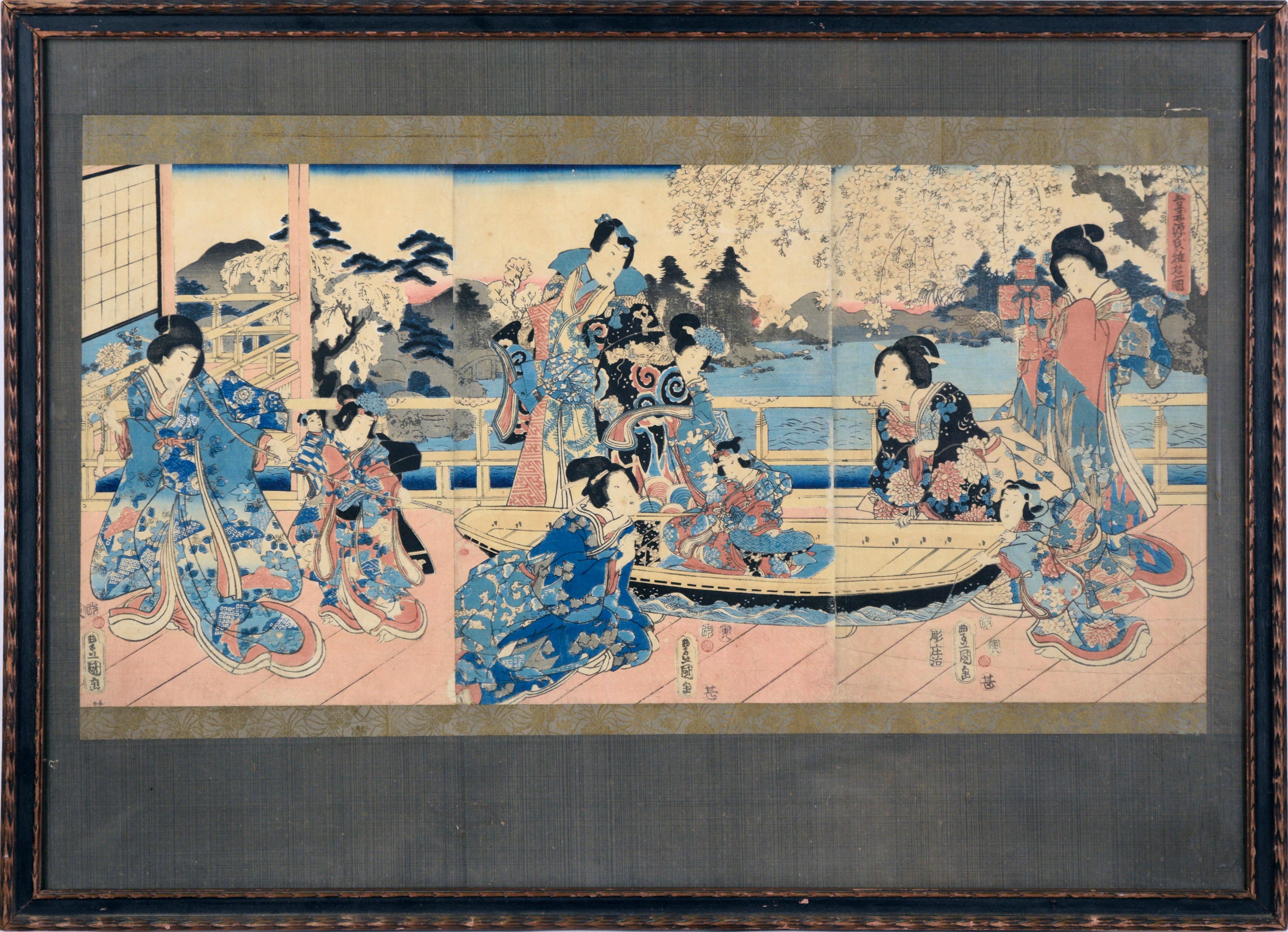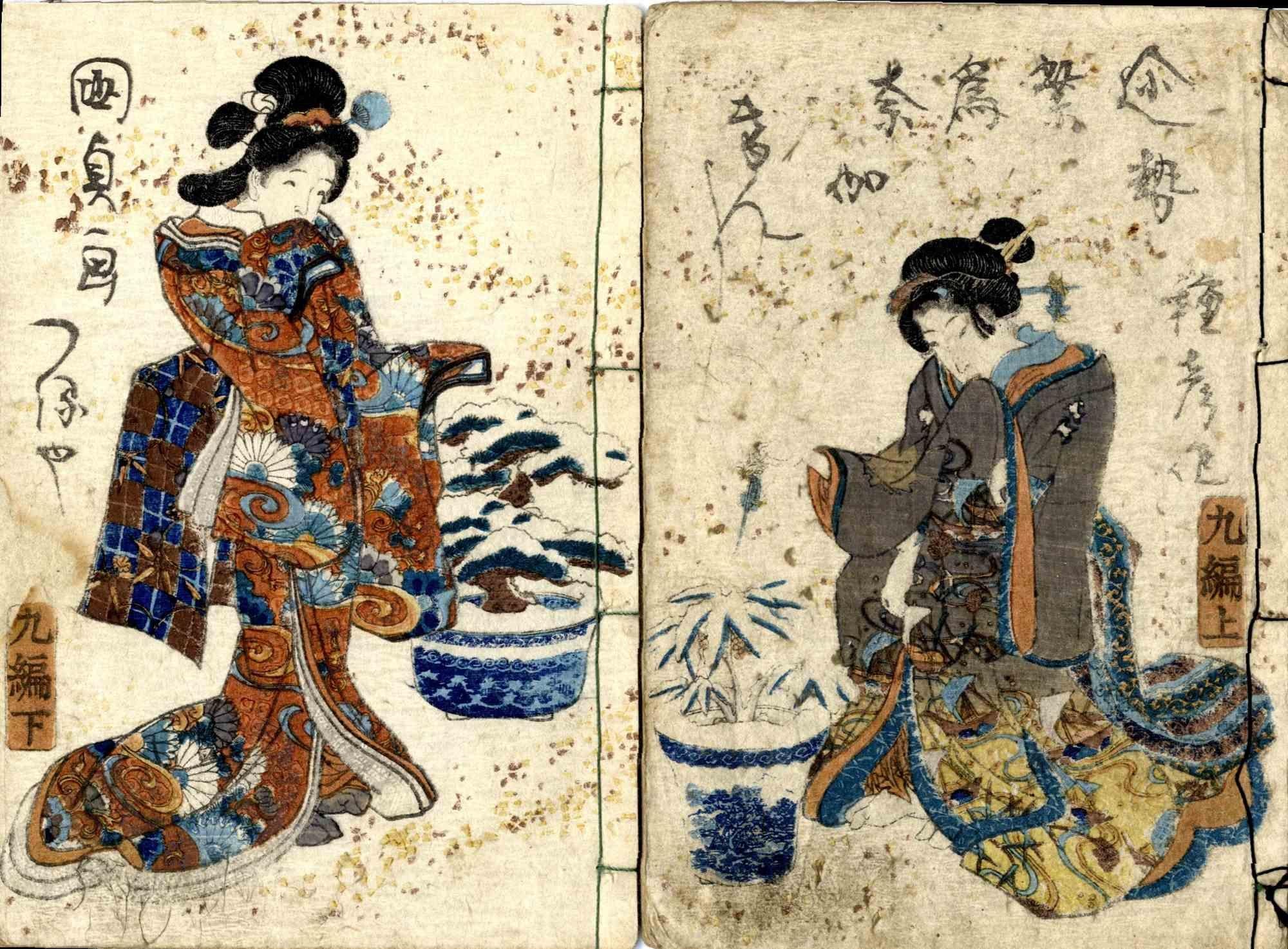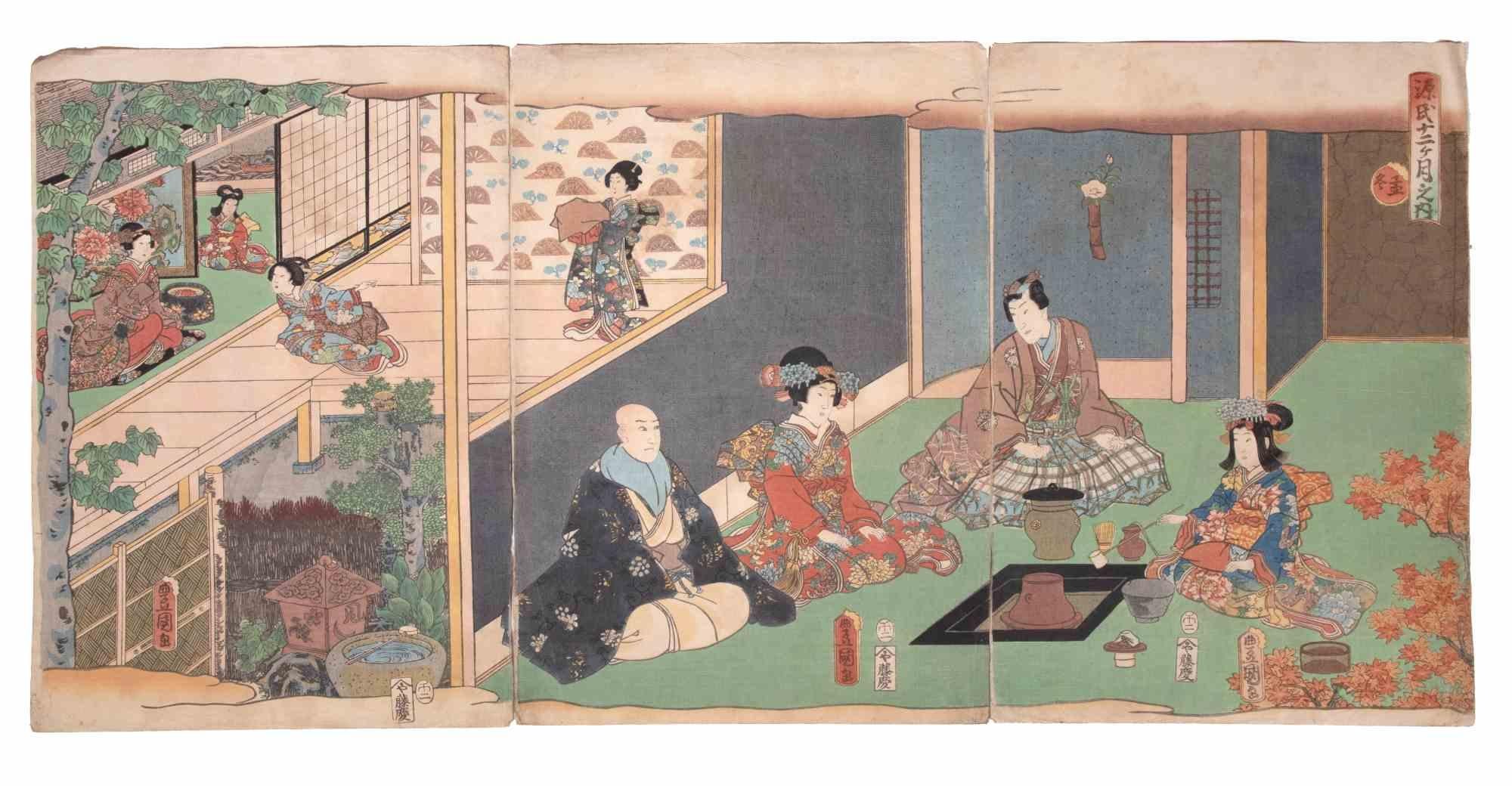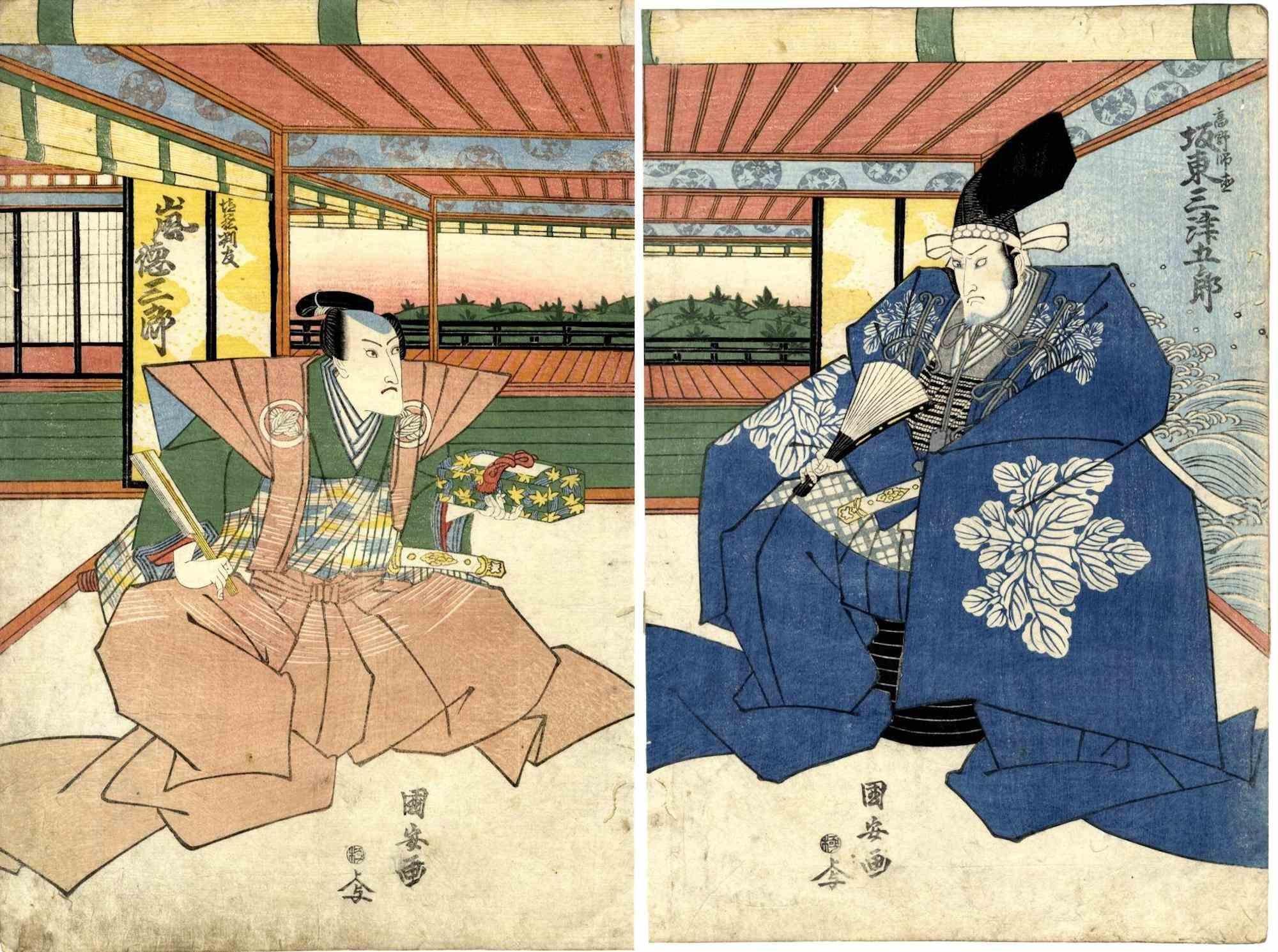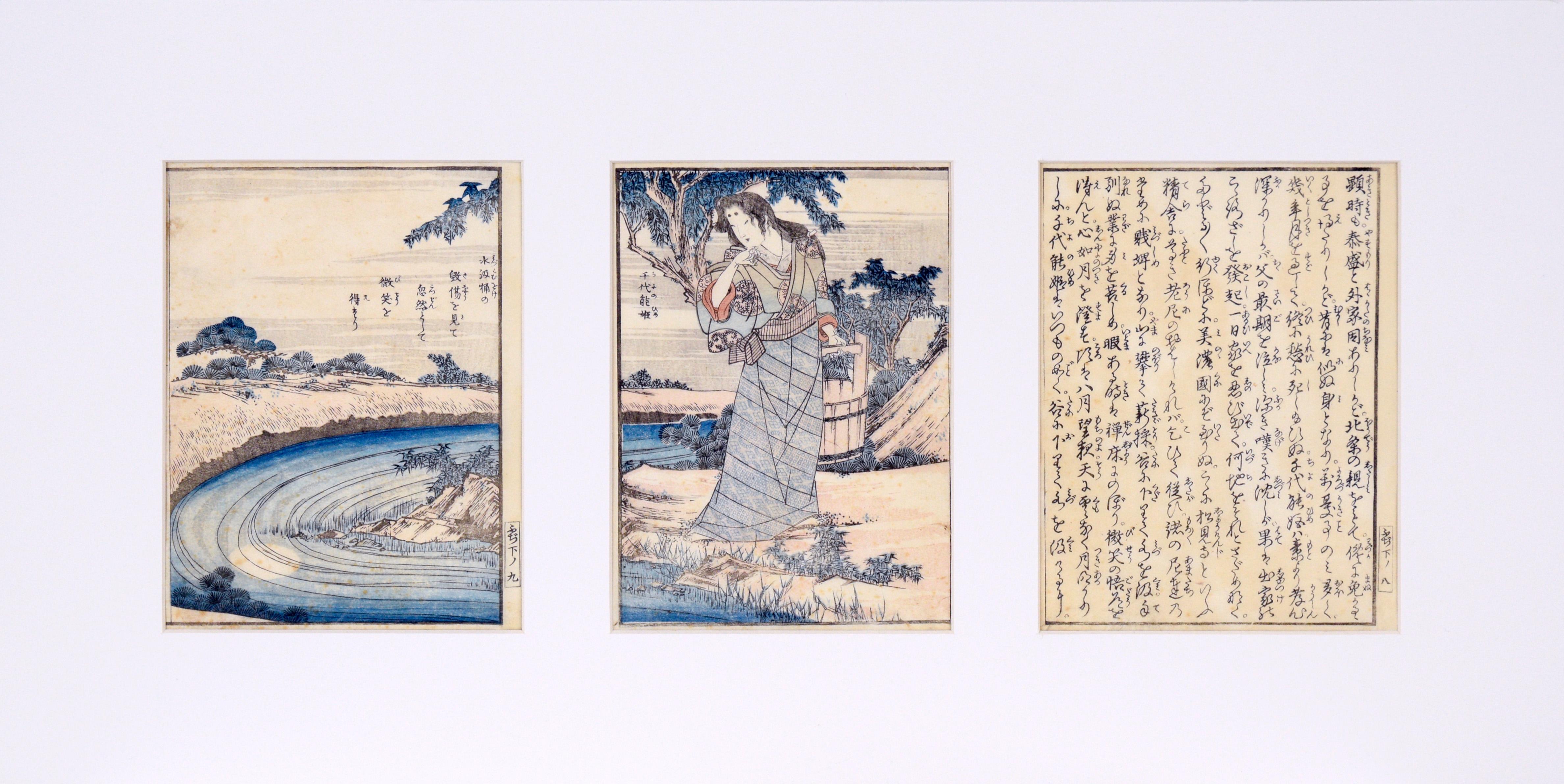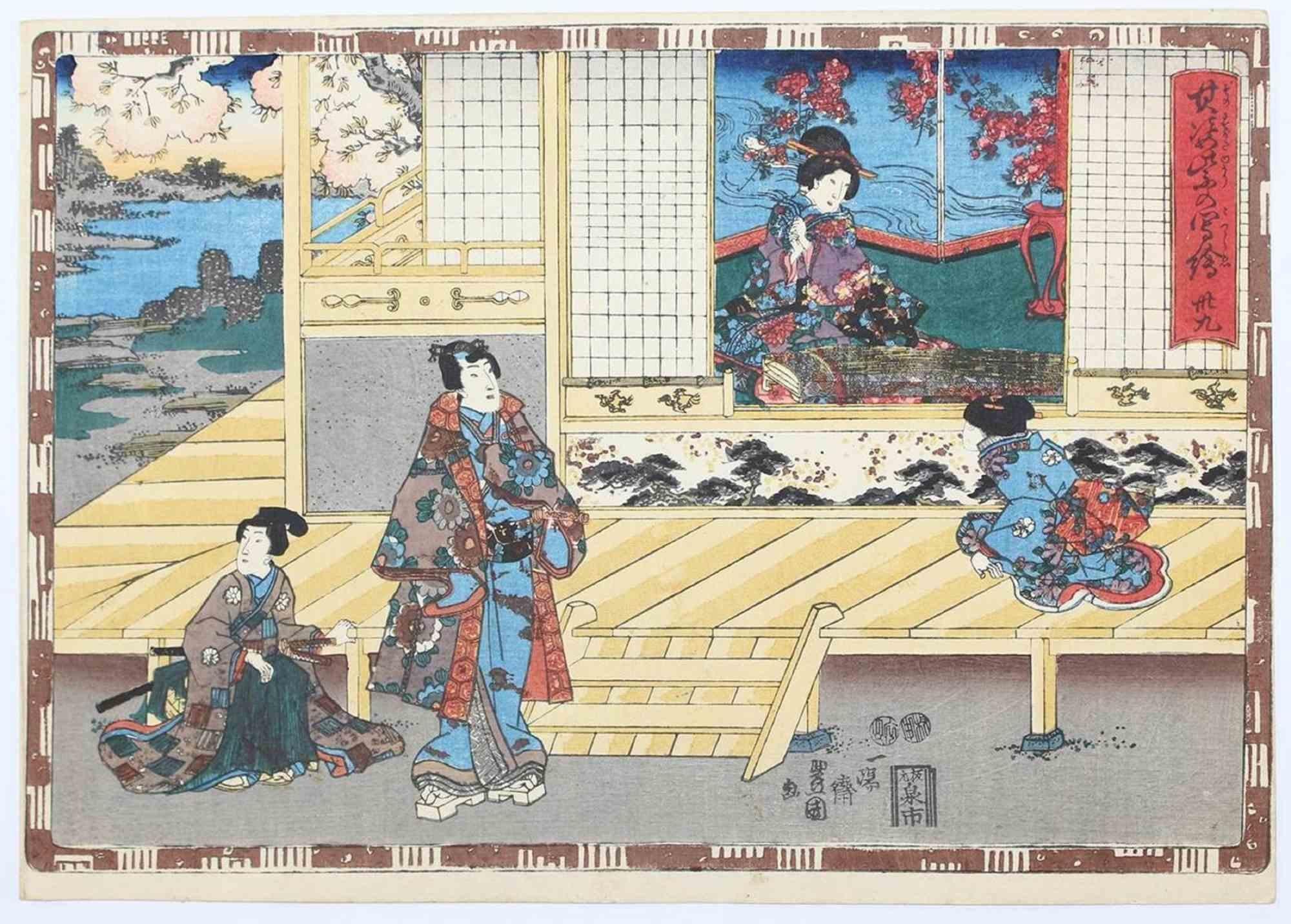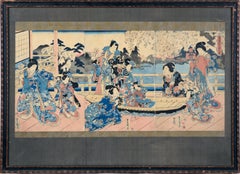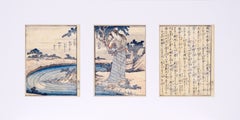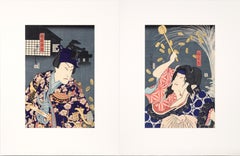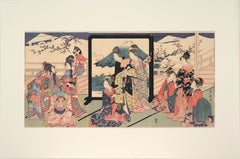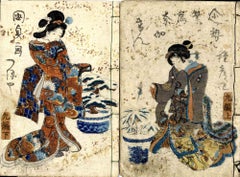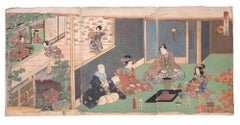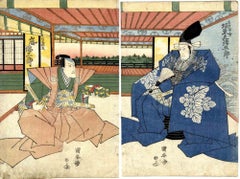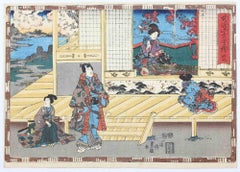Items Similar to The Four Seasons: Spring Japanese Woodblock Triptych ink on Paper Tales of Genji
Want more images or videos?
Request additional images or videos from the seller
1 of 23
Utagawa Kuniteru IThe Four Seasons: Spring Japanese Woodblock Triptych ink on Paper Tales of Genjiearly 1800s
early 1800s
$1,480
$1,85020% Off
£1,112.84
£1,391.0520% Off
€1,292.28
€1,615.3520% Off
CA$2,066.79
CA$2,583.4920% Off
A$2,292.22
A$2,865.2820% Off
CHF 1,203.76
CHF 1,504.7020% Off
MX$28,150.12
MX$35,187.6420% Off
NOK 15,238.49
NOK 19,048.1120% Off
SEK 14,370.10
SEK 17,962.6320% Off
DKK 9,641.82
DKK 12,052.2720% Off
Shipping
Retrieving quote...The 1stDibs Promise:
Authenticity Guarantee,
Money-Back Guarantee,
24-Hour Cancellation
About the Item
The Four Seasons: Spring - Japanese Woodblock Triptych in Ink on Paper
Colorful kabuki scene by Utagawa Kuniteru (Japanese, active 1818-1860). Attractive scene from the "Tale of Genji" of Prince Genji and a young nobleman at a country estate, the verandah opening onto a beautiful garden. Outside, two young women at right wear robes with wings like those of the mandarin ducks swimming in the lake, while three other beauties flutter about the landscape with butterfly wings. The young nobleman watches them over his shoulder with a slightly surprised expression as he stands in the center. A small girl kneels beside him holding a large vase with flowering branches in it, her kimono sleeves also patterned to look like butterfly wings. Genji sits on a cushion at right, holding a fan and smiling happily. Blossoming cherry trees and yellow roses frame the view of the garden. A lovely design with wonderful detail in the setting.
Publisher's marks in the lower right corner.
Presented in a gold colored frame with a blue mat.
Frame size: 18.75"H x 14.75"W (each)
Image size: 12.5"H x 8.75"W (each)
Utagawa Kuniteru (Japanese: 歌川国輝; active 1818-1860) was an ukiyo-e artist in the tradition of the Utagawa school. Born in Edo (Tokyo), he studied under both Kunisada and Toyokuni I. He produced prints of a wide variety of subjects, including many depicting the increasing Western influence on Japan, with his main output taking the form of book illustrations and single-sheet ukiyo-e.
He was known by various names: he called himself Kunitsuna II or Ichiransai until the Ganji era (1864/1865). Before 1844 he may also have been known as Sadashige and signed works using the name Ichiyusai.
As Kunitsuna II he concentrated on caricatures and scenes from his travels. After taking his master's name, he expanded his range to include scenes of sumo wrestling, and the modernization and westernization of Japan.
- Creator:Utagawa Kuniteru I (Japanese)
- Creation Year:early 1800s
- Dimensions:Height: 18.75 in (47.63 cm)Width: 44.25 in (112.4 cm)Depth: 0.75 in (1.91 cm)
- Medium:
- Movement & Style:
- Period:
- Condition:Tonal ageing to paper, as expected. Some glue residue at edges from a previous mounting. Small punctures in lower right corner from bookworms.
- Gallery Location:Soquel, CA
- Reference Number:Seller: DBH8690, DBH8691, DBH86921stDibs: LU54212652582
About the Seller
5.0
Platinum Seller
Premium sellers with a 4.7+ rating and 24-hour response times
Established in 1986
1stDibs seller since 2014
2,945 sales on 1stDibs
Typical response time: <1 hour
- ShippingRetrieving quote...Shipping from: Soquel, CA
- Return Policy
Authenticity Guarantee
In the unlikely event there’s an issue with an item’s authenticity, contact us within 1 year for a full refund. DetailsMoney-Back Guarantee
If your item is not as described, is damaged in transit, or does not arrive, contact us within 7 days for a full refund. Details24-Hour Cancellation
You have a 24-hour grace period in which to reconsider your purchase, with no questions asked.Vetted Professional Sellers
Our world-class sellers must adhere to strict standards for service and quality, maintaining the integrity of our listings.Price-Match Guarantee
If you find that a seller listed the same item for a lower price elsewhere, we’ll match it.Trusted Global Delivery
Our best-in-class carrier network provides specialized shipping options worldwide, including custom delivery.More From This Seller
View AllElegant Amusements of Eastern Genji - Japanese Triptych Woodblock Print on Paper
By Utagawa Kunisada (Toyokuni III)
Located in Soquel, CA
Elegant Amusements of Eastern Genji - Japanese Triptych Woodblock Print on Paper
Dynamic woodblock print with several elegantly dressed figures by Utag...
Category
1850s Edo Figurative Prints
Materials
Paper, Ink, Woodcut
3 Panel Hand Colored Japanese Woodcut Print Lithograph
By Keisai Eisen
Located in Soquel, CA
3 Panel Hand Colored Japanese Woodcut Print Lithograph
Three panel hand colored woodcut lithograph from Nanso Satomi hakkenden, Tale of the Eight Dogs...
Category
Early 19th Century Edo Figurative Prints
Materials
Paper, Ink, Woodcut
$920 Sale Price
20% Off
The Samurai Genta Kajiwara - Japanese Woodblock Diptych in Ink on Paper
By Utagawa Yoshitora
Located in Soquel, CA
The Samurai Genta Kajiwara - Japanese Woodblock Diptych in Ink on Paper
Boldly colored woodblock by Utagawa Yoshitora (Japanese, active c.1840-1880)...
Category
1860s Edo Figurative Prints
Materials
Paper, Ink, Woodcut
$1,280 Sale Price
20% Off
"Toy Horse Dance" Japanese Woodblock Triptych with Beauties and Mt Fuji
Located in Soquel, CA
"Toy Horse Dance" Japanese Woodblock Triptych with Beauties and Mt Fuji
Vibrant three-panel woodblock print by Utagawa Toyohiro (Japanese,...
Category
Early 20th Century Edo Figurative Prints
Materials
Ink, Rice Paper, Woodcut
Annual Events for Young Murasaki (July) - Tales of Genji - Japanese Woodblock
By Utagawa Kunisada (Toyokuni III)
Located in Soquel, CA
Annual Events for Young Murasaki (July) - Tales of Genji - Japanese Woodblock
Rightmost panel a triptych, depicting monthly events for Wakamurasaki (Young Murasaki). This is the month of July. There appears to be a lesson taking place, possibly for writing or poetry.
Artist: Toyokuni III/Kunisada (1786 - 1864)
Publisher: Ebisu-ya Shoshichist
Presented in a new blue mat.
Mat size: 19"H x 13"W
Paper size: 14.5"H x 10"W
Commentary on the triptych:
In the Edo period, Tanabata was designated as one of the five seasonal festivals, and became an annual event for the imperial court, aristocrats, and samurai families, and gradually came to be celebrated by the general public. Its origins are said to be a combination of the Kikoden festival, which originated from the Chinese legend of Altair and the Weaver Girl, and Japan's ancient Tanabata women's faith. Ink is ground with dew that has accumulated on potato leaves, poems and wishes are written on five colored strips of paper, which are then hung on bamboo branches to celebrate the two stars that meet once a year. Although the illustration is a Genji painting...
Category
1850s Realist Figurative Prints
Materials
Printer's Ink, Rice Paper, Woodcut
"Various Himochi" Wagashi Festival Japanese Woodblock Print by Utagawa Toyokuni
By Utagawa Toyokuni
Located in Soquel, CA
"Various Himochi" Wagashi Festival Japanese Woodblock Print by Utagawa Toyokuni
Rare oversized early 19th century 5-tiered woodblock by Utagawa Ichiyosai Toyokuni, (Japan, 1769-1825), a Japanese lord and wife oversee a sekku festival of food, music, and dolls or toys. '"oshi" is the first day of “Mi (Snake)” in the third month of the lunar calendar. This day, known in modern Japan as the Girls' Festival, originated in China as a form of purification ceremony in which water and drinking peach blossom wine were used to drive away evil. Many kinds of hishi-mochi appear in this picture of hina ningyo (dolls associated with Hinamatsuri, or the Girl’s Day) from Omochae.
The custom of eating special dishes at events throughout the year and at milestones in people's lives has existed since ancient times. This paragraph specifically focuses on the annual event called sekku, and life events that involve eating sweets. Joshi is the first day of “Mi (Snake)” in the third month of the lunar calendar. This day, known in modern Japan as the Girls' Festival, originated in China as a form of purification ceremony in which water and drinking peach blossom wine were used to drive away evil. According to the Keiso saijiki, in ancient China, on the third day of the third lunar month, people ate “ryuzetsuhan,” which is the juice of gogyo (Jersey cudweed) mixed with rice flour and nectar. In Japan, there is a record in the Heian period history book Nihon Montoku tenno jitsuroku [839-5] that it was an annual event to make kusamochi using gogyo on the third day of the third month of the lunar calendar, which may have been influenced by Chinese customs.
The tradition of eating kusamochi on the third day of the third month of the lunar calendar continued after that. By the Edo period, however, hishimochi had come to be used as a sweet to serve on the third day of the third month. A picture of a hishimochi is included in the Morisada manko , which we mentioned in Part 1. According to it, hishimochi in the Edo period were often three layers of green-white-green instead of the now common red-white-green. However, it is possible to see from our collection that not all hishimochi were made in this way. Omochae published in 1857, is a good example. Omochae is a type of ukiyoe print...
Category
1820s Edo Figurative Prints
Materials
Ink, Rice Paper, Woodcut
You May Also Like
A Rural Genji - Woodcut by Utagawa Kunisada - 1829-1842
By Utagawa Kunisada (Toyokuni III)
Located in Roma, IT
A rural Genji is an original artwork realized in 1829-1842 by Utagawa Kunisada (1786-1865).
Illustrated book in two volumes. Book title "Nise Murasaki Inaka Jenji", 9th instalment....
Category
19th Century Modern Figurative Prints
Materials
Woodcut
Genji in the Twelve Months - Woodcut by Utagawa Toyokuni III - 1858
By Utagawa Kunisada (Toyokuni III)
Located in Roma, IT
Genji in the Twelve Months / The Tenth Month (Moto) is a tryptich woodcut print realized by Utagawa Toyokuni III in 1858.
Very good condition except for some minor signs of wear.
Category
1850s Modern Figurative Prints
Materials
Woodcut
Plate from Kanadeon Chushing - Woodcut Print by Utagawa Kuniyasu - 1820
Located in Roma, IT
Plate from Kanadeon Chushingura is an original modern artwork realized by Utagawa Kuniyasu in 1820 ca.
Woodcut Print Oban Dyptich Format.
Enya Hanga...
Category
19th Century Modern Figurative Prints
Materials
Woodcut
Yugiri - Woodcut by Utagawa Kunisada - 1850s
By Utagawa Kunisada (Toyokuni III)
Located in Roma, IT
Yugiri is an original artwork realized in the 1850s by Utagawa Kunisada (1786-1865).
Chapter 39 of the story Genji Monogatari. Color woodcut around 1851. Signed: Ichiyossai Toyokun...
Category
1850s Modern Figurative Prints
Materials
Woodcut
Bijinga - Woodcut by Utagawa Toyohiro - Early 19th Century
Located in Roma, IT
Bijinga (New year festivities) is an original modern artwork realized by Utagawa Toyohiro in the Early 19th Century.
Woodcut Print Oban Format
New year festivities, two elegant la...
Category
19th Century Modern Figurative Prints
Materials
Paper, Woodcut
The Radiant Prince Genji - Woodcut Print by Utagawa Kunisada - 1850s
Located in Roma, IT
Plate from Faithful Images of the Radiant Prince Genji is an original modern artwork realized by Utagawa Kunisada in 1850s.
Woodcut print Oban yokoe format.
From the series "Sono ...
Category
19th Century Modern Figurative Prints
Materials
Woodcut
More Ways To Browse
Antique Paper Fans
Antique Triptych
The Four Seasons 19th Century
Large Japanese Fan
Antique Stand Fan
Rose Mandarin
Antique Fan Vases
Tokyo Japan Vase
1800s Fan
Antique Wrestling
Blue Cherry Blossom Vases
Japanese Woodblock Tree
Sumo Wrestler
Sumo Wrestling
Single Rose Vase
Japanese Sumo Art
Sumo Wrestler Art
Tale Of Genji
